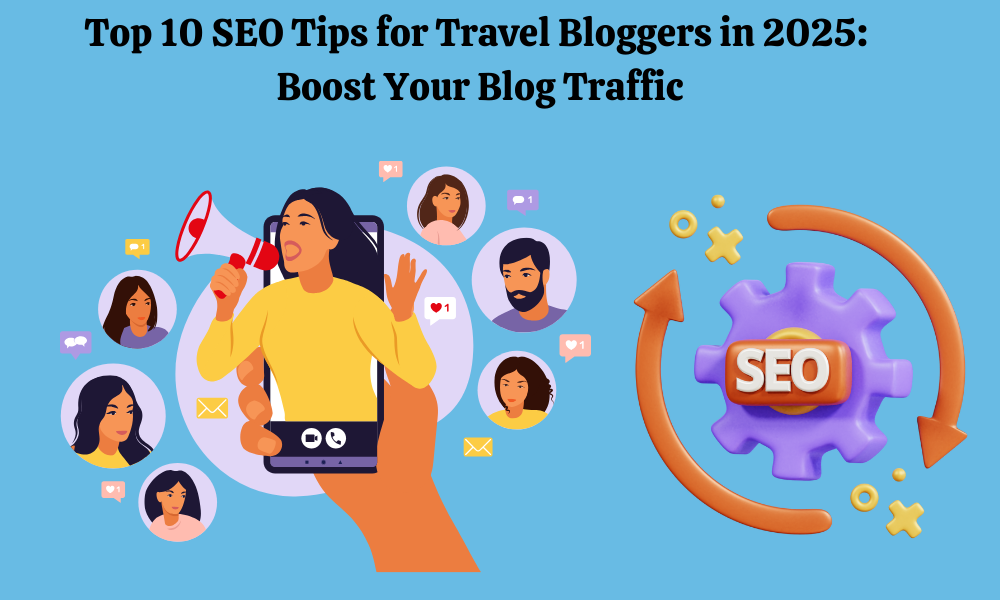Top 10 SEO Tips for Travel Bloggers in 2025: Boost Your Blog Traffic
Travel blogging is an exciting and rewarding niche, but with so many bloggers vying for attention, standing out can be challenging. Search Engine Optimization (SEO) is your secret weapon to attract more readers, rank higher on Google, and grow your audience. As we move into 2025, SEO trends are evolving, and travel bloggers need to stay ahead of the curve. In this guide, we’ll share the top 10 SEO tips for travel bloggers in 2025 to help you optimize your blog and achieve long-term success.
Why SEO Matters for Travel Bloggers
SEO is the process of optimizing your website to rank higher in search engine results pages (SERPs). For travel bloggers, this means more visibility, more organic traffic, and ultimately, more readers and revenue.
In 2025, SEO will be more important than ever as competition increases and search engines like Google continue to refine their algorithms. By implementing these SEO tips, you can ensure your travel blog remains relevant and reaches your target audience effectively.
Tip 1: Focus on Long-Tail Keywords
Long-tail keywords are specific, multi-word phrases that users search for. They often have lower competition and higher conversion rates, making them ideal for travel bloggers.
How to Use Long-Tail Keywords:
- Use tools like Google Keyword Planner, Ahrefs, or SEMrush to find long-tail keywords related to your niche.
- Incorporate these keywords naturally into your blog posts, titles, and meta descriptions.
Example:
Instead of targeting “Paris travel,” focus on “best budget hotels in Paris for families.”
Tip 2: Optimize for Voice Search
Voice search is on the rise, with more people using devices like Google Assistant, Siri, and Alexa to find information. Travel bloggers should optimize their content for voice search to stay ahead.
How to Optimize for Voice Search:
- Use conversational language and natural phrases in your content.
- Answer common questions in your blog posts (e.g., “What’s the best time to visit Bali?”).
- Focus on local SEO by including location-specific keywords.
Tip 3: Create High-Quality, Evergreen Content
Evergreen content is content that remains relevant and valuable over time. For travel bloggers, this could include guides, tips, and destination overviews.
How to Create Evergreen Content:
- Write detailed guides like “10 Must-Visit Destinations in Italy” or “How to Plan a Solo Trip to Japan.”
- Update your old posts regularly to keep them accurate and relevant.
- Use a mix of text, images, and videos to make your content more engaging.
Tip 4: Leverage Visual SEO
Visual content, such as images and videos, is crucial for travel blogs. Optimizing your visuals for SEO can help you rank higher and attract more readers.
How to Optimize Visual Content:
- Use descriptive file names for your images (e.g., “sunset-in-santorini.jpg”).
- Add alt text to your images, including relevant keywords.
- Compress images to improve page load speed.
- Use video content to showcase destinations and experiences.
Tip 5: Build High-Quality Backlinks
Backlinks are links from other websites to your blog. They are a key ranking factor for SEO and can significantly boost your blog’s authority.
How to Build Backlinks:
- Guest post on reputable travel websites.
- Collaborate with other bloggers and influencers in your niche.
- Create shareable content like infographics or travel guides.
- Reach out to websites and ask them to link to your content.
Tip 6: Optimize for Mobile Users
With more people using mobile devices to browse the internet, having a mobile-friendly blog is essential.
How to Optimize for Mobile:
- Use a responsive design that adapts to different screen sizes.
- Ensure your website loads quickly on mobile devices.
- Use large, easy-to-click buttons and readable fonts.
Tip 7: Use Schema Markup
Schema markup is a type of structured data that helps search engines understand your content better. It can improve your chances of appearing in rich snippets, which can drive more traffic to your blog.
How to Use Schema Markup:
- Add schema markup for articles, reviews, and FAQs.
- Use tools like Google’s Structured Data Markup Helper to generate schema code.
- Test your schema markup using Google’s Rich Results Test.
Tip 8: Focus on Core Web Vitals
Core Web Vitals are a set of metrics that measure user experience, including page load speed, interactivity, and visual stability. Google uses these metrics as ranking factors, so optimizing them is crucial.
How to Improve Core Web Vitals:
- Use a fast and reliable hosting provider.
- Optimize images and videos to reduce file size.
- Minimize the use of heavy scripts and plugins.
- Use a Content Delivery Network (CDN) to improve load times.
Tip 9: Engage with Your Audience
Engaging with your audience can improve your blog’s SEO by increasing dwell time and reducing bounce rates.
How to Engage Your Audience:
- Respond to comments and questions on your blog and social media.
- Encourage readers to share their travel experiences in the comments.
- Create interactive content like polls, quizzes, and surveys.
Tip 10: Stay Updated on SEO Trends
SEO is constantly evolving, and staying updated on the latest trends is essential for long-term success.
How to Stay Updated:
- Follow reputable SEO blogs like Moz, Ahrefs, and Search Engine Journal.
- Attend webinars and conferences on SEO and digital marketing.
- Join online communities and forums for travel bloggers.
Bonus Tip: Use AI Tools Wisely
AI tools like ChatGPT and Jasper can help you generate content ideas, optimize your blog posts, and even write drafts. However, always review and edit AI-generated content to ensure it aligns with your voice and style.
SEO is a powerful tool for travel bloggers, and by implementing these top 10 SEO tips for 2025, you can boost your blog’s visibility, attract more readers, and achieve your goals. Remember, SEO is a long-term strategy, so be patient and consistent with your efforts.
Start applying these tips today, and watch your travel blog soar to new heights in 2025 and beyond. Happy blogging!




